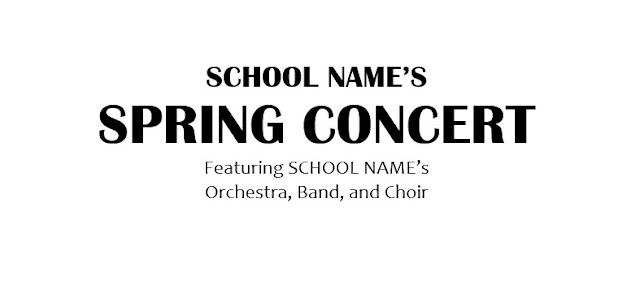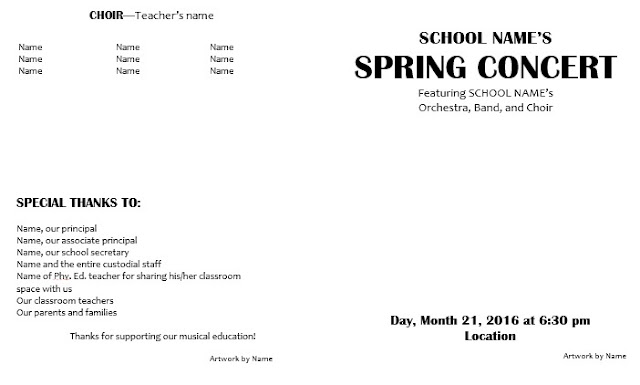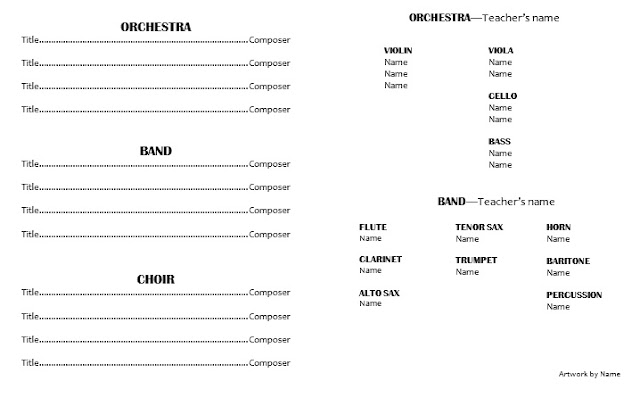Sunday, February 28, 2016
Elementary Orchestra Solo/Ensemble, Part 2: Timeline and Documents
When planning out the Solo/Ensemble unit, I work backwards from the date of the festival itself. Since we meet for small groups only once a week, I really have to be mindful of the S/E timeline so students have enough time to prepare.
Saturday: Solo/Ensemble festival
1 week before: Tour day! Students perform for one classroom during their small group time. If there's extra time, we'll go to a second performance site like the office or special education room or music room. Students perform their solo pieces first, and we end with ensembles. Before the school day, I set up chairs for cellists and music stands outside the different classrooms so everything is ready to bring into the classroom for the performance time and all I have to lug around the school is my camera :) To get comment sheets ready for the Saturday festival, I use mail merge on Word to automatically add the headings (student name, piece, school, site, time, etc.) and print them on colored paper by school to enable quick sorting after the event.
2 weeks before: Dress rehearsal day! Students get in front of their small group, say their introduction, and practice playing through their piece(s) without stopping. I jot down final comments to help during their last week of home practice. I do not want tour day to be the first time students are up in front of an audience playing through their piece. I want them to get their jitters out of the way during dress rehearsal day and to make sure everyone has their introduction planned out. Any late S/E signups should all be in, so I put together the Saturday morning schedule and share that with students and families.
3-4 weeks before: Rehearse! During small groups, a big chunk of time is dedicated to rehearsing with students' ensemble groups. Students also figure out what they're going to say for their introduction, using the introduction template as a guide. I also send out a tour sign-up sheet (using Google Sheet) where teachers can choose a time that works best for them to have students come perform for their class.
5-6 (or so) weeks before: The last 5-10 minutes of small groups are dedicated to practicing individual parts of S/E pieces. I quickly go around helping students--especially in the area of rhythm--to hopefully make the first combined rehearsal with their ensemble go smoothly. The warm-up for each of these weeks gets a different emphasis, based on the different categories on the S/E rubric: rhythm, LH, RH, etc. This is the time when I tell students about the Saturday morning optional festival and send home the sign-up sheet for that. I remind students that everyone will go on tour during school, and then the S/E festival on that Saturday morning is a highly encouraged optional event. We briefly look over the rubric to see which areas the adjudicator would be commenting on.
2nd week of unit: During full orchestra, students form their ensembles and fill out a planning sheet, indicating which piece(s) they're planning to learn. Every student turns one in, and there's a place to list a solo piece and an ensemble piece plus who is in their group. I type these up into one master list for myself to make sure everyone is accounted for. I talk with those students who signed up for just a solo to see if they also had an interest in playing in an ensemble and help set that up if desired. Repertoire choices may change over the next few weeks, but at least everyone is leaving class that day with an idea of which piece(s) to focus their home practice on.
1st week of unit: Explain what Solo/Ensemble is, hand out the list of choices plus additional repertoire, and give some time to try out options. I tell students that at the end of this unit we will be going on tour around school to perform our piece(s) for an audience.
This timeline covers roughly two months of school. During this time--especially at the beginning of the unit--we are focused on more than just Solo/Ensemble in orchestra, and this advance planning helps me to balance all different areas of what students are learning during this time.
See also:
Monday, February 15, 2016
Elementary Orchestra Solo/Ensemble, Part 1: Description and Additional Repertoire
For the elementary orchestra students in our district, we create our own Solo/Ensemble festival each spring. Since it's not an "official" Solo/Ensemble festival, we can create our own list of repertoire choices suitable for first- and second-year players and really customize the event to make it work for our students.
This is a big unit for us in orchestra, and it's a great experience for our beginners on many levels. They get to prepare a solo and/or ensemble (duet or trio for first-year students; up to a quartet for second-year students), so the outcome of this performance really hinges on how much individual effort each student puts into it. Performing alone is a really different feeling compared to performing as a full orchestra. During this unit, we take a look at the whole process of selecting and learning a piece, getting it ready for performance, and then performing it for an audience. Once students are in middle school and can participate in the "real" Solo/Ensemble festival, they already have an idea of what to expect.
Students take time to try out lots of pieces from the list of choices before settling on their repertoire, and I give time during full orchestra for students to form ensembles. They enjoy getting to play with students who play different instruments than them. The month before Solo/Ensemble, I form small groups based on S/E ensemble groups, which generally includes some mixed instrumentation. We do a dress rehearsal during small groups, where each student introduces what they're playing and something interesting about the piece or something to listen to or watch for, and this is when I do my formal assessment and give last-minute tips.
The next week during small groups, we go on tour around their school. I create a Google Doc with available times for teachers to sign up on, and then each small group gets to perform for one classroom. If it's a time slot I'm having trouble filling, we can always go perform for the people in the office. This is an authentic performance experience, as students get to experience what it's like actually performing for an audience. The audience members always have great questions for our performers afterwards, and it's built-in school-wide exposure for the orchestra program. I make sure to bring a camera and get pictures of each solo and ensemble performing to post in the orchestra room, and on the weekly orchestra newsletter.
Then, that Saturday is Solo/Ensemble. Since it occurs outside of the school day, not all students are available to participate. That's another reason we all go on tour at school--everyone gets to do that, and then the Solo/Ensemble festival is the icing on the cake. We alternate each year between the two high schools in town so students get a sneak peek at the music wings where they will be attending school in the future. Performers dress up, families are welcome to listen, and area teachers and musicians serve as our adjudicators.
Adjudicators fill out a rubric with comments for each set of performers, and they have a few minutes to work with each student too. These one-on-one teaching moments are so valuable for our students, and they really reinforce what we're working on at school too.
It takes a lot of planning to get all the registrations turned in, the schedule created, performance rubrics printed, the sites set up, all the instruments tuned etc. but I'm glad we do it.
Most students perform music either from their book or from this "Additional Repertoire" sheet. "Sweetly Sings the Donkey" is the popular ensemble choice with the beginners--they like the musical "hee-haws" in the last line :) Feel free to use or update these sheets to make them work for you:
Enjoy!
See also:
Monday, February 8, 2016
Template for a Concert Program and Concert Flyers
I enjoy making the programs for each of my schools' concerts throughout the year. I get the program information from the band and choir teachers and then add the students' names and concert pieces to the program template. I like to change font combinations each year, keeping the program to two fonts--one for headings and one for everything else. Text boxes help me easily move groups of names around the page.
Students decorate concert flyers a few weeks before the concert and hang them around the school and community. If a student shows me their completed flyer, I'll scan a copy for myself so I can include some student artwork in the concert program too. I use Paint to select the portion of the artwork I want to use and then copy/paste it into the Word document. I've seen some really impressive student artwork. Using clip art is another possibility to add interest to all the text of a concert program, but I really like the personalized touch of using student artwork.
In addition to a place to list all the pieces on the concert by ensemble, the concert program template includes a place for student names for band, orchestra, and choir as well as a "special thanks" area. This template makes a program that's one piece of paper folded in half.
Feel free to use these as a starting point to create your own concert programs and flyers!
Monday, February 1, 2016
Music In Our Schools Month: Quotes
For Music In Our Schools Month, I combined student quotes and pictures with quotes from some more well-known figures. Here are the famous quotes, and here are the pictures that match up.
The prompts for the student responses were:
§ What music means to me:
§ Music is important because…
§ Why I chose to play the instrument that I play:
§ Without music…
Check out this post for more MIOSM ideas including templates for the written prompts.
Subscribe to:
Posts (Atom)







